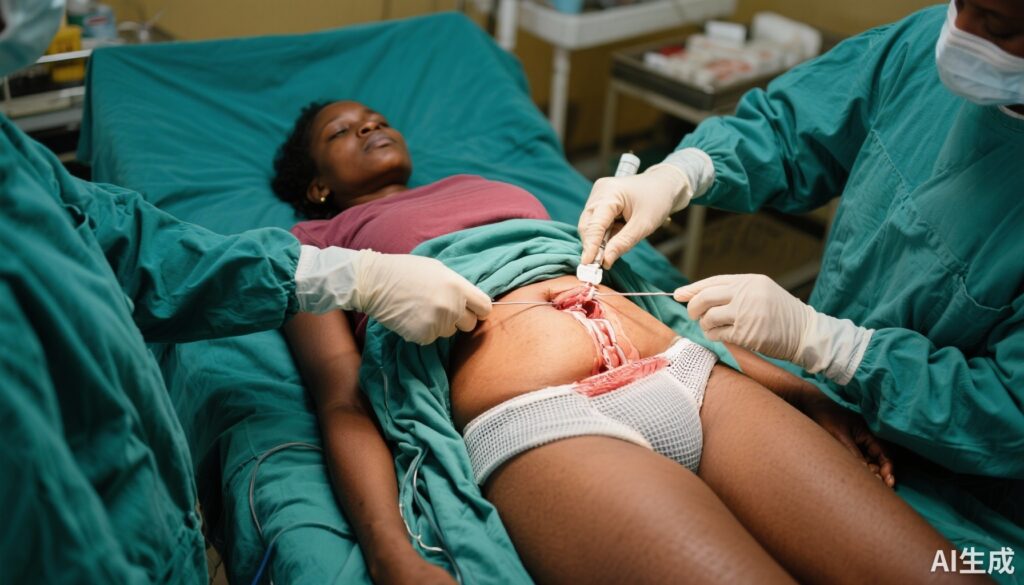Highlight
– A randomized clinical trial compared open anterior mesh (OAM) repair and modified open anterior mesh (MOAM) repair for groin hernias in women.
– Nearly 45% of women had femoral hernias, emphasizing the importance of femoral canal exploration.
– No significant difference in hernia recurrence at 1 year was observed between OAM (4.1%) and MOAM (7.1%) repairs.
– MOAM is a viable open surgical option for women in low-resource settings lacking laparoscopic access.
Study Background and Disease Burden
Groin hernias represent one of the most common surgical problems worldwide, with a higher relative incidence of femoral hernias in women. Femoral hernias carry a heightened risk of incarceration and strangulation, necessitating reliable surgical repair. In high-income settings, laparoscopic methods have become preferred due to reduced postoperative pain and faster recovery. However, in many low- and middle-income countries (LMICs), laparoscopic repair remains largely unavailable due to limited resources, infrastructure, and expertise.
Open repair techniques remain the mainstay for groin hernia treatment in these regions. Yet, standard open anterior mesh repair often focuses on inguinal hernias, potentially overlooking femoral hernias, which may co-exist or be misdiagnosed preoperatively. Given the high prevalence of femoral hernias among women, especially in sub-Saharan Africa, a surgical approach that ensures adequate femoral canal exposure is essential for effective hernia management and reduction of recurrence.
Study Design
This investigator-initiated, double-blind, parallel-group randomized clinical trial was conducted at two public hospitals in Northern Uganda from October 2019 to February 2023. The trial enrolled 200 adult women (≥18 years) with primary groin hernias, categorized as American Society of Anesthesiologists (ASA) class I or II, capable of providing informed consent.
Participants were randomized to receive standard open anterior mesh repair (OAM, control arm) or a modified open anterior mesh repair (MOAM, intervention arm). The MOAM technique involves deliberate opening of the transversalis fascia and creation of a mesh flap to cover the femoral canal, thereby addressing undetected femoral hernias effectively.
The primary outcome was groin hernia recurrence at 1 year postoperatively. Secondary outcomes included complication rates and safety evaluations.
Key Findings
Among 200 women (mean age 52.7 ± 14.0 years), 99 were allocated to OAM repair and 101 to MOAM repair. Remarkably, 45% of participants (89/200) presented with femoral hernias, underscoring their high local prevalence. Notably, 35 participants (35.4%) in the control group received the MOAM procedure due to intraoperative detection of femoral hernias, reflecting protocol-adherent crossover for optimal repair.
At 1 year post-surgery, overall hernia recurrence was low at 5.6% (11 of 195 participants). Intention-to-treat analysis revealed recurrences in 4.1% (4/97) of the OAM group versus 7.1% (7/98) of the MOAM group. The absolute difference of -3.0 percentage points (95% confidence interval, -9.5 to 3.4) was statistically nonsignificant (P = .36), indicating comparable effectiveness.
Safety profiles were favorable for both techniques, with no increase in adverse events associated with the modified approach despite more extensive dissection.
The high frequency of femoral hernias and their intraoperative identification highlights the clinical importance of systematically exposing the femoral canal during open groin hernia repair in women, particularly where laparoscopic support is inaccessible.
Expert Commentary
These findings contribute valuable data addressing a critical surgical gap in LMICs, where access to minimally invasive laparoscopic techniques remains limited. Standard open anterior mesh repair is established; however, femoral hernias may be underrecognized, leading to inadequate repairs and risk of recurrence or complications.
The modified technique, introducing intentional opening of the transversalis fascia and femoral canal mesh coverage, is not yet a globally standard practice but offers a pragmatic solution tailored to women’s anatomy and local hernia epidemiology. Although the MOAM group did not show statistically significant superiority, the clinical relevance of femoral canal exposure for early detection and comprehensive repair cannot be overstated.
Limitations include the single regional setting and intermediate-term follow-up, warranting broader multicenter studies and longer surveillance to ascertain long-term outcomes and generalizability.
Conclusion
This well-designed randomized trial establishes that both open anterior mesh and the modified open anterior mesh repairs provide safe and effective options for groin hernia repair in women, including those with femoral hernias, within resource-limited settings. The modified technique’s emphasis on femoral canal exposure addresses a commonly overlooked hernia type contributing to improved diagnostic accuracy and potentially reduced recurrence in subpopulations with high femoral hernia prevalence.
These results support adaptation of hernia repair techniques that reflect local disease patterns and resource availability, improving surgical care equity. Future guideline updates should consider incorporating modified open repair techniques where laparoscopic resources are scarce, enhancing outcomes for women globally.
References
1. Matovu A, Nordin P, Wladis A, et al. Open Anterior Mesh Repair vs Modified Open Anterior Mesh Repair for Groin Hernia in Women: A Randomized Clinical Trial. JAMA Surg. 2025;160(9):946-953. doi:10.1001/jamasurg.2025.2244.
2. Fitzgibbons RJ Jr, Giobbie-Hurder A, Gibbs JO, et al. Watchful waiting vs repair of inguinal hernia in minimally symptomatic men: a randomized clinical trial. JAMA. 2006;295(3):285-292. doi:10.1001/jama.295.3.285.
3. Simons MP, Aufenacker T, Bay-Nielsen M, et al. European Hernia Society guidelines on the treatment of inguinal hernia in adult patients. Hernia. 2009;13(4):343-403. doi:10.1007/s10029-009-0529-7.



